2015《精神分裂症防治指南》第2版解读(郭中孟)
- 格式:ppt
- 大小:3.40 MB
- 文档页数:68
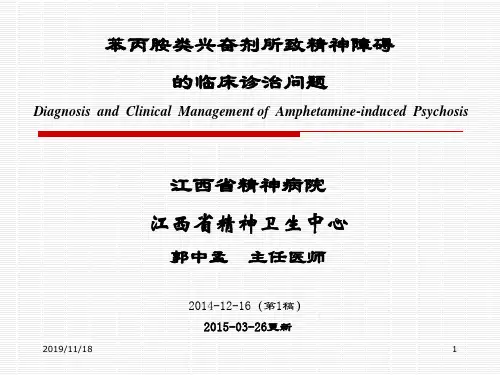


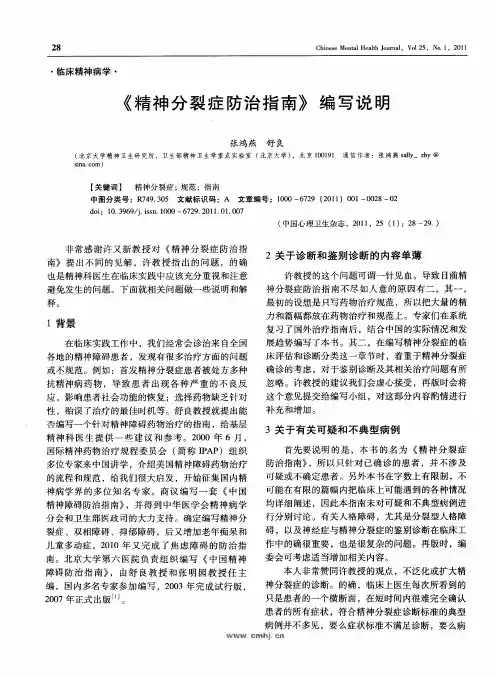
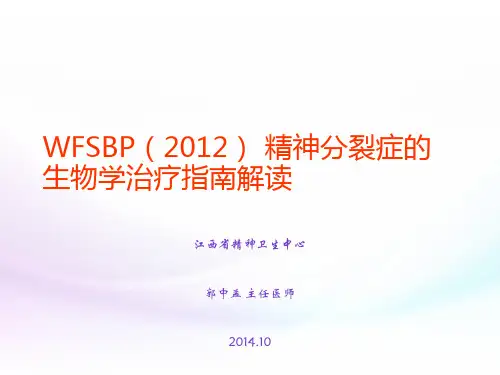
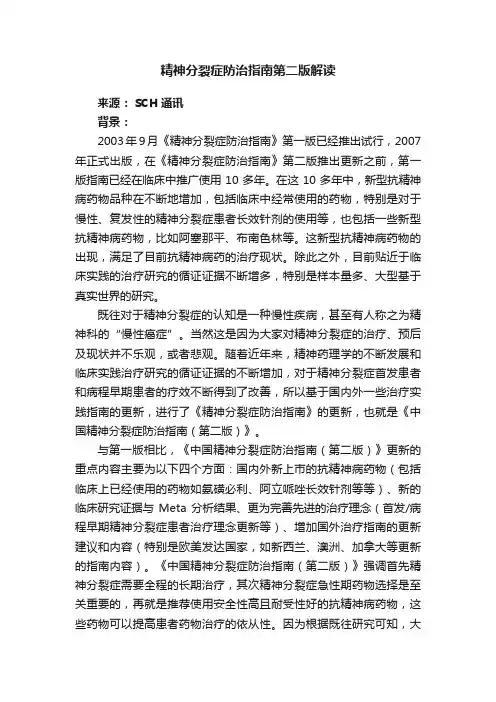
精神分裂症防治指南第二版解读来源: SCH通讯背景:2003年9月《精神分裂症防治指南》第一版已经推出试行,2007年正式出版,在《精神分裂症防治指南》第二版推出更新之前,第一版指南已经在临床中推广使用10多年。
在这10多年中,新型抗精神病药物品种在不断地增加,包括临床中经常使用的药物,特别是对于慢性、复发性的精神分裂症患者长效针剂的使用等,也包括一些新型抗精神病药物,比如阿塞那平、布南色林等。
这新型抗精神病药物的出现,满足了目前抗精神病药的治疗现状。
除此之外,目前贴近于临床实践的治疗研究的循证证据不断增多,特别是样本量多、大型基于真实世界的研究。
既往对于精神分裂症的认知是一种慢性疾病,甚至有人称之为精神科的“慢性癌症”。
当然这是因为大家对精神分裂症的治疗、预后及现状并不乐观,或者悲观。
随着近年来,精神药理学的不断发展和临床实践治疗研究的循证证据的不断增加,对于精神分裂症首发患者和病程早期患者的疗效不断得到了改善,所以基于国内外一些治疗实践指南的更新,进行了《精神分裂症防治指南》的更新,也就是《中国精神分裂症防治指南(第二版)》。
与第一版相比,《中国精神分裂症防治指南(第二版)》更新的重点内容主要为以下四个方面:国内外新上市的抗精神病药物(包括临床上已经使用的药物如氨磺必利、阿立哌唑长效针剂等等)、新的临床研究证据与Meta分析结果、更为完善先进的治疗理念(首发/病程早期精神分裂症患者治疗理念更新等)、增加国外治疗指南的更新建议和内容(特别是欧美发达国家,如新西兰、澳洲、加拿大等更新的指南内容)。
《中国精神分裂症防治指南(第二版)》强调首先精神分裂症需要全程的长期治疗,其次精神分裂症急性期药物选择是至关重要的,再就是推荐使用安全性高且耐受性好的抗精神病药物,这些药物可以提高患者药物治疗的依从性。
因为根据既往研究可知,大约70%的精神分裂症患者依从性较差,能够出院后巩固治疗2年以上的患者不足30%,临床治疗现状不容乐观。



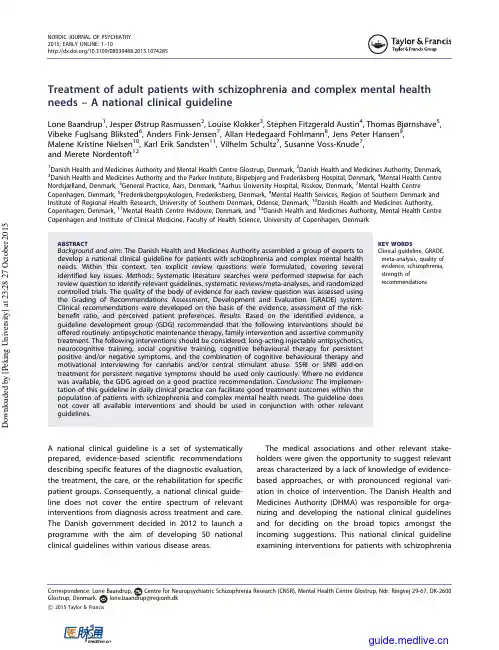
NORDIC JOURNAL OF PSYCHIATRY 2015;EARLY ONLINE:1–10/10.3109/08039488.2015.1074285Treatment of adult patients with schizophrenia and complex mental health needs –A national clinical guidelineLone Baandrup 1,Jesper Østrup Rasmussen 2,Louise Klokker 3,Stephen Fitzgerald Austin 4,Thomas Bjørnshave 5,Vibeke Fuglsang Bliksted 6,Anders Fink-Jensen 7,Allan Hedegaard Fohlmann 8,Jens Peter Hansen 9,Malene Kristine Nielsen 10,Karl Erik Sandsten 11,Vilhelm Schultz 7,Susanne Voss-Knude 7,and Merete Nordentoft 121Danish Health and Medicines Authority and Mental Health Centre Glostrup,Denmark,2Danish Health and Medicines Authority,Denmark,3Danish Health and Medicines Authority and the Parker Institute,Bispebjerg and Frederiksberg Hospital,Denmark,4Mental Health Centre Nordsjælland,Denmark,5General Practice,Aars,Denmark,6Aarhus University Hospital,Risskov,Denmark,7Mental Health CentreCopenhagen,Denmark,8Frederiksbergpsykologen,Frederiksberg,Denmark,9Mental Health Services,Region of Southern Denmark and Institute of Regional Health Research,University of Southern Denmark,Odense,Denmark,10Danish Health and Medicines Authority,Copenhagen,Denmark,11Mental Health Centre Hvidovre,Denmark,and 12Danish Health and Medicines Authority,Mental Health Centre Copenhagen and Institute of Clinical Medicine,Faculty of Health Science,University of Copenhagen,DenmarkABSTRACTBackground and aim :The Danish Health and Medicines Authority assembled a group of experts to develop a national clinical guideline for patients with schizophrenia and complex mental health needs.Within this context,ten explicit review questions were formulated,covering several identified key issues.Methods :Systematic literature searches were performed stepwise for each review question to identify relevant guidelines,systematic reviews/meta-analyses,and randomized controlled trials.The quality of the body of evidence for each review question was assessed using the Grading of Recommendations Assessment,Development and Evaluation (GRADE)system.Clinical recommendations were developed on the basis of the evidence,assessment of the risk-benefit ratio,and perceived patient preferences.Results :Based on the identified evidence,a guideline development group (GDG)recommended that the following interventions should be offered routinely:antipsychotic maintenance therapy,family intervention and assertive community treatment.The following interventions should be considered:long-acting injectable antipsychotics,neurocognitive training,social cognitive training,cognitive behavioural therapy for persistent positive and/or negative symptoms,and the combination of cognitive behavioural therapy and motivational interviewing for cannabis and/or central stimulant abuse.SSRI or SNRI add-on treatment for persistent negative symptoms should be used only cautiously.Where no evidence was available,the GDG agreed on a good practice recommendation.Conclusions :The implemen-tation of this guideline in daily clinical practice can facilitate good treatment outcomes within the population of patients with schizophrenia and complex mental health needs.The guideline does not cover all available interventions and should be used in conjunction with other relevant guidelines.KEY WORDSClinical guideline,GRADE,meta-analysis,quality of evidence,schizophrenia,strength ofrecommendationsA national clinical guideline is a set of systematically prepared,evidence-based scientific recommendations describing specific features of the diagnostic evaluation,the treatment,the care,or the rehabilitation for specific patient groups.Consequently,a national clinical guide-line does not cover the entire spectrum of relevant interventions from diagnosis across treatment and care.The Danish government decided in 2012to launch a programme with the aim of developing 50national clinical guidelines within various disease areas.The medical associations and other relevant stake-holders were given the opportunity to suggest relevant areas characterized by a lack of knowledge of evidence-based approaches,or with pronounced regional vari-ation in choice of intervention.The Danish Health and Medicines Authority (DHMA)was responsible for orga-nizing and developing the national clinical guidelines and for deciding on the broad topics amongst the incoming suggestions.This national clinical guideline examining interventions for patients with schizophreniaCorrespondence:Lone Baandrup,Centre for Neuropsychiatric Schizophrenia Research (CNSR),Mental Health Centre Glostrup,Ndr.Ringvej 29-67,DK-2600Glostrup,Denmark.lone.baandrup@regionh.dk !2015Taylor &FrancisD o w n l o a d e d b y [P e k i n g U n i v e r s i t y ] a t 23:28 27 O c t o b e r 2015and complex mental health needs was developed from June 2014to April 2015.It was published online by the DHMA in Danish on 22May 2015(the full report is available from http://sundhedsstyrelsen.dk/da/udgivel-ser/2015/nkr-skizofreni).This article summarizes the contents of this guideline.AimsThe aim of this study was to develop an evidence-based national clinical guideline for the treatment of patients with schizophrenia and complex mental health needs.The guideline comprised the following 10explicit review questions:Pharmacological treatment(1)What are the consequences of reducing the cloza-pine dosage in schizophrenia patients with satisfac-tory symptomatic improvement,but with plasma clozapine levels above the upper limit in the therapeutic range?(2)What is the effect of long-acting injectable anti-psychotics in schizophrenia patients with poor medication adherence and persisting positive symptoms?(3)What is the effect of SSRI/SNRI add-on therapy totreat persistent negative symptoms in patients with schizophrenia?(4)What is the effect of discontinuing antipsychotictreatment in patients with schizophrenia and insuf-ficient response to previous antipsychotic treatment (provided adequate dosing and duration of several antipsychotic compounds including clozapine)?Psychosocial and psychotherapeutic treatment(5)What is the effect of family intervention in patientswith schizophrenia and functional impairment?(6)What is the effect of neurocognitive training inpatients with schizophrenia and functional impairment?(7)What is the effect of social cognitive training inpatients with schizophrenia and functional impairment?(8)What is the effect of cognitive behavioural therapyin patients with schizophrenia and functional impairment?(9)What is the effect of combining cognitive behav-ioural therapy and motivational interviewing in the treatment of schizophrenia patients with co-morbid cannabis and/or central stimulant abuse?Access and engagement(10)What is the effect of assertive community treat-ment (ACT)in schizophrenia patients with difficul-ties retaining contact with outpatient mental health care facilities?Materials and methodsThe clinical guideline was developed according to the Grading of Recommendations Assessment,Develop-ment and Evaluation (GRADE)system ().The DHMA assembled a guideline development group (GDG)comprising professionals in psychiatry,clinical psychology,nursing,general practice,and academic experts in psychiatry and psychology.Mental health care users were not represented in the GDG.The chair of the GDG was appointed by the DHMA,and the members of the GDG were appointed by an open recruitment process during which relevant organ-izations were asked to nominate candidates.An aca-demic review team was appointed by the DHMA.This review team undertook the systematic literature searches,reviewed and presented the evidence to the GDG,managed the process,and drafted the guideline.The academic review team produced the GRADE evi-dence profiles and the Summary of Findings Tables using GRADE profiler (GRADEpro)software (version 3.6).These tables were used to summarize the evidence for each outcome in addition to the quality of the evidence,which was evaluated according to the presence and severity of methodological limitations,inconsistency,indirectness,imprecision and publication bias (1).The quality of the evidence was graded according to the GRADE system as high (ÈÈÈÈ),moderate (ÈÈÈ*),low (ÈÈ**),or very low (È***).The definitions of each grading level were as follows:‘‘high quality’’,further research is very unlikely to change our confi-dence in the estimate of effect;‘‘moderate quality’’,further research is likely to have an important impact on our confidence in the estimate of effect and may change the estimate;‘‘low quality’’,further research is very likely to have an important impact on our confidence in the estimate of effect and is likely to change the estimate;very low quality ,we are very uncertain about the estimate (1).In advance of the first assembly of the GDG,the chair and the review team decided on a more narrow definition of the plex mental health needs were defined in this context as:1)functional impairment due to persisting symptoms despite relevant treatment with antipsychotics,2)co-morbid cannabis and/or cen-tral stimulant abuse,or 3)difficulties establishing and2L.BAANDRUP ET AL.D o w n l o a d e d b y [P e k i n g U n i v e r s i t y ] a t 23:28 27 O c t o b e r 2015maintaining a stable contact with the mental health care services.Because of the time and work frames of the project,other relevant topics,e.g.co-morbid medical disorders,physical health and alcohol abuse were not covered.Furthermore,alcohol abuse in people with mental disorders will be covered in a future national clinical guideline.After defining the focus of the guideline,the chair,in collaboration with the review team,suggested ten explicit interventions to be evaluated.These suggestions were revised at the first meeting with the GDG and again after feedback from a reference group.The reference group represented various stakeholders including governmental institutions,regional and local mental health care organ-izers,and representatives from national service user groups.The interventions which were finally selected were formulated according to the PICO principle with specific definitions of the patient population (P),the intervention (I),the comparison (C),and the outcomes of interest (O)as defined by the GDG.For each review question a systematic literature search and an evaluation of the literature retrieved was performed.The literature search was carried out from 3July to 5December 2014.The following databases were searched:Guidelines International Network,NICE,National Guideline Clearinghouse,Scottish Intercollegiate Guidelines Network,HTA database,SBU (Sweden),Socialstyrelsen (Sweden),Helsedirektoratet (Norway),Kunnskapssenteret (Norway),MEDLINE,Embase,PsycINFO and CINAHL.Detailed search strategies for each review question and each database are available from http://sundhedsstyrel-sen.dk/da/udgivelser/2015/nkr-skizofreni.The literature search was organized into three con-secutive steps.First,existing international guidelines were retrieved and scrutinized for any relevant content according to the defined review questions.All relevant guidelines were evaluated using the Appraisal of Guidelines for Research and Evaluation Instrument (AGREE II),which systematically assesses all aspects of guideline quality (2).The next step involved searching for systematic reviews and meta-analyses from the date where the relevant retrieved guideline(s)(if any)ended their literature search.All relevant materials according to the specified review questions at this step were assessed for quality using the tool AMSTAR that systematically assesses the methodological quality of systematic reviews (3).During the final step,literature searches for relevant primary literature (randomized controlled trials)were performed from the date where the relevant retrieved systematic reviews and meta-analyses (if any)ended their literature search.All relevant materials were assessed for quality using the Cochrane Collaboration’s tool for assessing risk of bias (4).Each step of bothliterature selection and evaluation was performed inde-pendently by two reviewers:one person from the academic review team and one person from the GDG.For each review question and at each step of the literature search,as much material as possible was extracted,on the condition that the material was of sufficient methodological quality.For each outcome in each review question,a meta-analysis was performed using the random effects model due to expected heterogeneity among studies.For binary outcomes,the risk ratio (RR)was calculated,and for continuous outcomes measured on different scales,the standar-dized mean difference (SMD)was reported.If a continu-ous outcome was measured on only one scale,the mean difference between the intervention groups was calcu-lated.Heterogeneity among studies was assessed using I 2statistics.The risk of publication bias was estimated by visual inspection of funnel plots.After having retrieved and assessed the body of evidence of each review question,the review team presented this evidence to the GDG.The GDG then formulated recommendations for each intervention examined,taking into account the quality of the evidence,the balance between desirable and undesirable effects,and the perceived patient preference with regard to the intervention (1,5,6).In the absence of evidence,a group discussion and consensus process was adopted,and the GDG decided on a good practice recommendation.Various stakeholders had the opportunity to com-ment on the draft guideline during a consultation period preceding the publication of the guideline.Following the consultation,all comments from the stakeholders and two specifically appointed expert peer-reviewers were discussed by the review team and the GDG,and the guideline was revised accordingly by the anizational and health economic issues were per definition not considered in the development of this national clinical guideline.ResultsEach review question was explicitly defined,including identification of key outcome(s)and other important outcomes.The selection of outcome variables was in accordance with the views of the GDG,and included both efficacy,safety and tolerability variables as well as patient related outcomes.The meta-analytic results for each review question are presented in detail in the summary of findings tables available as online supple-mentary material to this article.The findings are summarized below together with the subsequent clinical recommendations.A summary of the recommendations is provided in Table 1.NORDIC JOURNAL OF PSYCHIATRY 3D o w n l o a d e d b y [P e k i n g U n i v e r s i t y ] a t 23:28 27 O c t o b e r 2015Pharmacological treatmentReview question 1addressed the clinical situation characterized by a satisfactory response and acceptable tolerability to clozapine treatment,but with plasma levels above the upper limit in the therapeutic range (defined as the range that includes 80%of patients treated with recommended or regular doses).This review question addressed the effects of lowering the dosage,as a response to the increased plasma level,compared with continued treatment with unchanged dosage.In clinical practice,clozapine dosage is often hastily reduced or the treatment is withdrawn as a sudden response to measurements of increased plasma levels.Such behaviour may contribute to psychotic relapses in patients previously well treated on clozapine.We found no literature that directly addressed this question,but we included in the GDG’s discussion a systematic literature review examining the evidence base for operating with an upper limit in the therapeutic range (7).The GDG concluded that there was no evidence for a safety-based upper limit of recommended clozapine plasma levels,but that increased plasma levels indicate that the responsible physician should reconsider whether dosage reduction is possible in order to minimize adverse reactions.However,if dosage reduc-tion is impossible or considered to be impossible fromprevious experience,measurements of increased cloza-pine levels should not by itself be considered a sufficient reason to reduce or even discontinue clozapine treat-ment.Consequently,the GDG concluded that it is good practice to adjust clozapine dosage according to the clinical response and the individual tolerability,even if this implies exceeding the upper limit in the defined therapeutic range.The GDG emphasized that in patients suffering from considerable adverse reactions,an increased level of plasma clozapine should always indicate a need for dosage reduction.Review question 2examined whether treatment with long-acting injectable (LAI)antipsychotics should be preferred above oral antipsychotics in patients with schizophrenia who do not use their prescribed anti-psychotic medication regularly.The body of evidence for this question consisted of a meta-analysis of randomized controlled trials (RCTs)examining the efficacy of LAI antipsychotics compared with oral antipsychotics in patients with schizophrenia (8)supplemented by add-itional relevant RCTs identified during the updated literature search (9–11).There were no differences in investigated parameters of efficacy (including relapse,hospitalization,and all-cause discontinuation)or adverse events between LAI and oral antipsychotic use (supple-mentary Table 1).However,the quality of the evidenceTable 1.Summary of the clinical guideline recommendations.Pharmacological treatment ˇIt is good practice to adjust clozapine dosage according to the clinical response and the individual tolerability,even if this implies exceeding the upper limit in the definedtherapeutic range.However,clozapine levels above the upper limit in this range always indicate a need to reconsider whether the patient could be managed on a lower dosage.ˇFor patients with no previous or current response to several antipsychotic compounds,including clozapine,it is good practice to gradually taper any on-going antipsychotic treatment,paying particular attention to the risk of aggravated psychotic symptoms.""Maintenance antipsychotic treatment should be used routinely for non-remitted schizophrenia patients with a previous antipsychotic drug response."Long-acting injectable antipsychotics should be considered for the treatment of schizophrenia patients with poor medication adherence.#SSRI/SNRI add-on therapy for persisting negative symptoms should be used only cautiously and after careful consideration.Psychosocial and psychotherapeutic treatment ""Family intervention should be offered routinely to schizophrenia patients with impaired functioning."Neurocognitive training should be considered for the treatment of schizophrenia patients with impaired functioning."Social cognitive training should be considered for the treatment of schizophrenia patients with impaired functioning."Cognitive behavioural therapy should be considered for the treatment of schizophrenia patients with persisting positive and/or negative symptoms."The combination of cognitive behavioural therapy and motivational interviewing should be considered for the treatment of schizophrenia patients with co-morbid cannabis and/or central stimulant abuse.Access and engagement ""Assertive community treatment should be used routinely for schizophrenia patients who cannot comply with usual outpatient mental health care settings.ˇGood practice (in the absence of any relevant evidence).""Strong recommendation for the experimental intervention."Weak recommendation for the experimental intervention.#Weak recommendation against the experimental intervention.4L.BAANDRUP ET AL.D o w n l o a d e d b y [P e k i n g U n i v e r s i t y ] a t 23:28 27 O c t o b e r 2015was downgraded due to indirectness,because a sub-group analysis suggested that the adherence rate was similar between the LAI and the oral group.As such,the patients included in the meta-analysis were considered not to be representative of the clinical population that is believed to benefit the most from LAI treatment,i.e.patients with poor adherence.Thus,there is a lack of RCTs to inform the treatment choice in patients with poor adherence,who will,for the most part,not be able to participate in regular RCTs with strict eligibility criteria and demands for multiple and extensive examinations.A better indication of the effectiveness of LAI antipsych-otics compared with oral antipsychotics in the relevant clinical population may be found in observational studies (cohort studies and mirror-image studies).The effectiveness outcomes in observational studies (12,13)point very strongly to a substantial benefit of LAI antipsychotics;the relative risk of hospitalization was more than halved for LAI compared with oral antipsych-otics (supplementary Table 1).However,the results from these studies must generally be considered with a potentially high risk of bias,and the quality of the evidence is generally rated lower than for RCTs.Thus,the GDG recommended considering the use of LAI anti-psychotics for treatment of schizophrenia patients with evident or suspected poor medication adherence.Review question 3investigated the efficacy of add-on treatment with selective serotonin reuptake inhibitor (SSRI),or serotonin and noradrenaline reuptake inhibitor (SNRI)to treat persisting negative symptoms in patients with schizophrenia.The patient population in this question did not include patients with depression (as verified clinically)nor substantial depressive symptoms (as verified by a Hamilton Depression Scale score below 15).The body of evidence for this question consisted of 15RCTs identified during the literature search (14–28).The current meta-analysis indicated a therapeutic bene-fit in favour of SSRIs regarding negative symptoms,but the effect size was small (SMD 0.31;95%CI 0.10–0.51)and the clinical relevance questionable (supplementary Table 2).The reporting of adverse events was poor and inconsistent across the studies.There was no difference between the groups regarding neurological adverse events,and psychotic symptoms did neither worsen nor improve with SSRI therapy.Obvious adverse reactions such as serotonergic and sexual side effects together with suicidal ideation were poorly reported in only a few of the studies.Neither absence nor presence of suicide or suicide attempts was mentioned in any of the studies.Hence,the GDG concluded that the risk–benefit ratio was uncertain and recommended that SSRI/SNRI add-on therapy for persisting negative symptoms should only be used cautiously.The evidence base for the use ofadd-on SNRI pointed in the same direction but consisted of only one smaller study and was thus very weak (supplementary Table 3).Review question 4examined the consequences of discontinuing antipsychotic treatment in schizophrenia patients who have not responded to previous antipsych-otic drug treatment including at least two different second-generation agents AND clozapine (all of suffi-cient dosage and duration).The body of evidence for this question comprised a meta-analysis comparing antipsychotic maintenance treatment with discontinu-ation in schizophrenia patients who were stabilized on antipsychotic medication prior to discontinuation (29).Only trials including non-remitted patients were included in the current body of evidence to match the a priori defined patient population for this national clinical guideline.The body of evidence was supple-mented by additional relevant RCTs identified during the updated literature search (30,31).There was strong evidence for a relapse preventing effect (RR 0.38;95%CI 0.32–0.46)of antipsychotic maintenance treatment in schizophrenia patients who had previously responded to antipsychotic drug treatment (only trials with such ‘‘enriched’’design were identified)(supplementary Table 4).For patients who have not previously shown any or very little response to antipsychotic treatment there was no evidence available to inform the choice of treatment.As is well documented,antipsychotic drugs are associated with numerous adverse reactions,and in the current meta-analysis a 2.8times higher risk of substantial weight gain as compared with placebo was documented (supplementary Table 4).Based on the current evidence,the GDG recommended the use of maintenance antipsychotics for non-remitted schizo-phrenia patients with a previous antipsychotic drug response as routine treatment.For patients with no previous or current response to several antipsychotic compounds,including clozapine,the GDG gave a good practice recommendation to taper gradually any on-going antipsychotic drug treatment paying close atten-tion to the risk of worsened psychotic symptoms.Psychosocial and psychotherapeutic treatmentReview question 5investigated the efficacy of family intervention as add-on to treatment as usual (TAU)in patients with schizophrenia and functional impairment,which was defined as diminished ability to perform instrumental activities of daily living (IADL).IADL are self-care activities enabling the individual to live independ-ently in a community,i.e.shopping,housekeeping,accounting,food preparation,telephone and transpor-tation.The body of evidence for this question consistedNORDIC JOURNAL OF PSYCHIATRY 5D o w n l o a d e d b y [P e k i n g U n i v e r s i t y ] a t 23:28 27 O c t o b e r 2015of a meta-analysis (32),supplemented by additional relevant RCTs identified during the updated literature search (33–44).The results of the current meta-analysis indicated a substantial beneficial effect of family inter-vention on risk of relapse (RR 0.55;95%CI 0.47–0.65),length of hospitalization (mean difference 3.20;1.86–4.54),carer satisfaction (SMD 0.34;0.05–0.63),quality of life (SMD 0.50;0.25–0.75)and social functioning (SMD 0.42;0.15–0.70)(supplementary Table 5).The GDG therefore recommended that family intervention should be offered routinely to schizophrenia patients with impaired functioning,despite the evidence of low quality.Review question 6evaluated the efficacy of neurocog-nitive training as add-on therapy to TAU in patients with schizophrenia and functional impairment,which was defined as diminished ability to perform IADL.The body of evidence consisted of a meta-analysis (45)and the most recent NICE guideline (46),supplemented by additional relevant RCTs identified during the updated literature search (47–63).The current meta-analysis did not find any effect on the global cognition score,but the intervention seemed to improve working memory (SMD 0.66;95%CI 0.27–1.04),social functioning (SMD 0.56;0.16–0.96),and to a lesser extent verbal learning (SMD 0.23;0.09–0.55)(supplementary Table 6).No adverse events were identified.Consequently,the GDG recom-mended that compensatory neurocognitive training (scaffolding)should be considered for the treatment of schizophrenia patients with impaired functioning.Review question 7evaluated the efficacy of social cognitive training (including social skills training)as add-on therapy to TAU in patients with schizophrenia and functional impairment,which was defined as diminished ability to perform IADL.The body of evidence comprised the latest NICE guideline (46)and a meta-analysis (64),supplemented by additional relevant RCTs identified during the updated literature search (65–71).The current meta-analysis identified a substantial therapeutic benefit of social cognitive training on emotion processing (SMD 0.81;95%CI 0.50–1.12)and social functioning at longest follow-up (SMD 0.54;0.04–1.04),but no effect on theory of mind (supplementary Table 7).No adverse events were identified.Based on the current evidence,the GDG recommended that social cognitive training should be considered for the treatment of schizophrenia patients with impaired functioning.Review question 8evaluated the efficacy of cognitive behavioural therapy (CBT)as add-on to TAU in patients with schizophrenia and functional impairment due to persisting positive and/or negative symptoms.The body of evidence was identified from the latest NICE guideline (46)and a recent meta-analysis (72),supplementedby additional relevant RCTs identified during the updated literature search (73,74).The current meta-analysis showed an effect of CBT on both positive and negative symptoms at the end of the intervention,but the effect sizes were small:SMD 0.34(95%CI 0.10–0.58)for positive symptoms and SMD 0.32(0.04–0.59)for negative symptoms (supplementary Table 7).These effect sizes were not considered large enough to justify a strong recommendation.There was no effect of the intervention on social functioning or other pre-defined important outcomes,and no effect on symptomatology 4–6months after the intervention.No adverse events were identified.Reflecting these findings,the GDG recommended that CBT should be considered for the treatment of schizophrenia patients with persisting positive and/or negative symptoms.Review question 9examined the efficacy of combining CBT and motivational interviewing (MI)compared with TAU for the treatment of cannabis and/or central stimulant abuse in patients with schizophrenia.The body of evidence consisted of a recent meta-analysis (75).No further RCTs were identified during the updated literature search.According to the current meta-analysis,there were no differences in key outcomes (cannabis or central stimulant abuse)or other important outcomes (e.g.symptoms,social functioning)between CBT/MI and TAU (supplementary Table 9).These results were based on only a few studies for each outcome,and for this reason it was not possible to draw any firm conclusions about the efficacy of CBT/MI versus TAU.However,as there is evidence for efficacy of both CBT and MI in treatment of substance abuse in general (i.e.not addressing patients with psychosis)(76,77),the GDG recommended that CBT/MI should be considered for the treatment of schizophrenia patients with co-morbid cannabis and/or central stimulant abuse.Access and engagementReview question 10investigated the efficacy of ACT compared with TAU in schizophrenia patients with difficulties retaining contact with outpatient mental health care facilities.The body of evidence was identified from the most recent NICE guideline (46)and a meta-analysis (78),supplemented by additional relevant RCTs identified during the updated literature search (79,80).The current meta-analysis showed substantial effects of the intervention with regard to preventing loss of contact (RR 0.40;95%CI 0.27–0.61)and reducing length of hospitalization (mean difference 0.86;0.35–1.38)(supplementary Table 10).In addition,the patients were more satisfied with ACT than TAU (SMD 0.75;0.11–0.38)and experienced fewer symptoms,albeit the effect6L.BAANDRUP ET AL.D o w n l o a d e d b y [P e k i n g U n i v e r s i t y ] a t 23:28 27 O c t o b e r 2015。

精神分裂症防治指南《精神分裂症防治指南》2007版中国精神障碍防治指南精神分裂症防治指南主编单位中华医学会前言由卫生部疾病预防控制局、中国疾病预防控制中心精神卫生中心和中华医学会精神病学分会牵头,编写《中国精神障碍防治指南》(以下简称《指南》)。
现已完成的是:精神分裂症、抑郁障碍、双相障碍、老年期痴呆和儿童注意缺陷多动障碍(ADHD)。
它们是《中国精神卫生工作规划,(2002~2010年)》(以下简称《规划》)中规定的重点疾病。
精神分裂症及双相障碍(旧称躁狂抑郁症),无疑是目前我国精神科服务的重点,而且在今后一段时间内仍然是我国专科服务的重点病种。
抑郁障碍,则包括一组以情绪低落为主要表现的精神疾病或精神障碍,患病率相当高,正在日益引起人们的重视。
以上三类精神疾病,均被世界卫生组织列为造成主要劳动力年龄段(15~45岁)的十大主要致病病种。
随着人口的老龄化,老年期痴呆将为今后一段时期中,致残率增长最快的精神障碍。
ADHD(旧称多动症),则为儿童最常见的精神障碍。
本《指南》参考和借鉴了国内外最新研究成果和指导建议,国际精神药物治疗规程委员会(IPAP)以及美国哈佛医学院的专家也多次提出咨询建议。
在格式方面则参照卫生部和高血压联盟制定的《中国高血压防治指南》(试行本)。
本《指南》的指导思想之一是:精神分裂症、抑郁障碍、双相障碍和ADHD 的发生和发展,都是生物一心理一社会因素综合作用的结果,它们的防治必须采取生物一心理一社会的综合措施。
.合适的精神药物治疗对上述疾病有肯定的效果,但是不能忽视也不能偏废心理社会干预。
老年期痴呆虽以生物学因素为主,但在干预方面,社会心理干预仍占重要地位。
本《指南》的另一指导思想是上述各类精神障碍,都呈慢性或慢性发作性过程,因而需要全病程防治。
在病程的不同阶段,采用以人为本的不同措施。
在《指南》的编写中,还考虑到我国的国情和现实的社会经济发展水平,特别是与我国情况相应的卫生经济学原则。